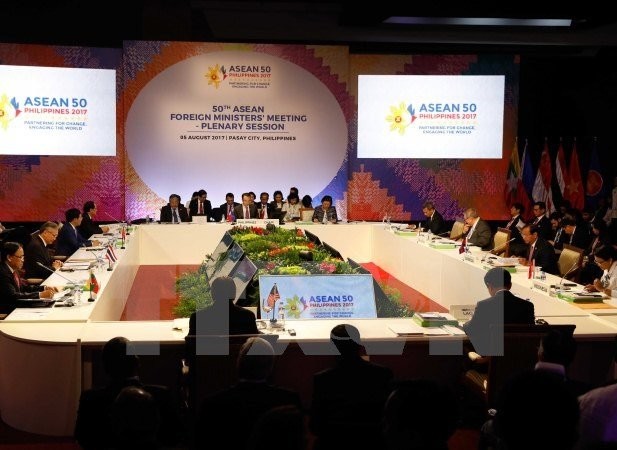(VOVWORLD) - The Association of Southeast Asian Nations (ASEAN) and China adopted this year the draft framework of the Code of Conduct of Parties in the East Sea after several years of negotiation. The agreement marks a milestone in restraining tensions in the East Sea.
 50th ASEAN Foreign Ministers' Meeting in Manila, the Philippines 50th ASEAN Foreign Ministers' Meeting in Manila, the Philippines |
Foreign Ministers of ASEAN countries and China officially approved the draft framework of the Code of Conduct in the East Sea (COC) on August 6 in Manila, the Philippines.
The move is the first step of the pragmatic negotiation process for an effective and legally-binding COC, contributing to maintaining peace and stability in the region. It is an outline of definition of the nature of the Code of Conduct detailing legal basis and the proper conduct of countries involved.
Initial step toward creating trust
After being first proposed the COC in the 1990s, ASEAN and China began seriously discussing the agreement in 2002 amidst increasing territorial disputes in the region. But during the past few years, COC negotiations have been repeatedly suspended.
After four years of official consultations, China and ASEAN completed a draft framework for the COC in the middle of 2017. Though it is far from finished, the draft reflects growing trust between the two sides. Deputy Director of the East Sea Research Institute Le Dinh Tinh said: “By its nature, the COC is not a mechanism to resolve disputes but it creates trust and dialogue between involved parties and defines principles for addressing problems and disputes like the principle of using peaceful measures such as dialogues, the principle of not using force or threatening to use force, and the principle of navigation freedom, safety, and security. The document will play an important role in enabling countries to resolve disputes.”
Since the Permanent Court of Arbitration made a ruling on the Philippines’ East Sea lawsuit last year, the region has been the focus of countries around the world. The East Sea has been on the agenda of several forums like the G7 and APEC. British Ambassador to Vietnam GILES Lever said: "We have to promote mutual clarity about the matter of international law. Since last year, progress toward agreeing a framework for the Code of Conduct in the South China Sea represents another important development to set light on areas of difference and areas of agreement as well in the interpretation and application of international maritime law."
More efforts needed to calm the East Sea region
The adoption of the draft framework of the COC reflects progress in the relationship between ASEAN and China and consensus among the 10 ASEAN countries. But it is just a start. It still needs the consensus of all involved parties to become legally effective, said Doctor Le Dinh Tinh: “International law plays an important role in this issue. Countries in the region need to be committed to international law to ensure order, peace, and stability. The 1982 UN Convention on the Law of the Sea serves as a mechanism to settle disputes but the COC cannot. ASEAN wants to accelerate negotiation for an effective and legally-binding COC.”
Whether the COC should be legally binding of COC will be a key issue in the negotiations between ASEAN and China.